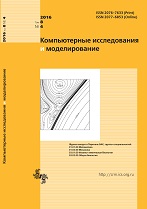|
This article is cited in 40 scientific papers (total in 40 papers)
SOLVING INDUSTRIAL PROBLEMS IN FLOWVISION SOFTWARE
Flowvision: industrial computational fluid dynamics
A. A. Aksenov
Joint Institute for High Temperatures RAS,
13 Izhorskaya st., Moscow, 125412, Russia
Abstract:
The work submits new release of the FlowVision software designed for automation of engineering calculations in computational fluid dynamics: FlowVision 3.09.05. The FlowVision software is used for solving different industrial problems. Its popularity is based on the capability to solve complex non-tradition problems involving different physical processes. The paradigm of complete automation of labor-intensive and time-taking processes like grid generation makes FlowVision attractive for many engineers. FlowVision is completely developer-independent software. It includes an advanced graphical interface, the system for specifying a compu-tational project as well as the system for flow visualization on planes, on curvilinear surfaces and in volume by means of different methods: plots, color contours, iso-lines, iso-surfaces, vector fields. Besides that, FlowVision provides tools for calculation of integral characteristics on surfaces and in volumetric regions.
The software is based on the finite-volume approach to approximation of the partial differential equations describing fluid motion and accompanying physical processes. It provides explicit and implicit methods for time integration of these equations. The software includes automated generator of unstructured grid with capability of its local dynamic adaptation. The solver involves two-level parallelism which allows calculations on computers with distributed and shared memory (coexisting in the same hardware). FlowVision incorporates a wide spectrum of physical models: different turbulence models, models for mass transfer accounting for chemical reactions and radioactive decay, several combustion models, a dispersed phase model, an electro-hydrodynamic model, an original VOF model for tracking moving interfaces. It should be noted that turbulence can be simulated within URANS, LES, and ILES approaches. FlowVision simulates fluid motion with velocities corresponding to all possible flow regimes: from incompressible to hypersonic. This is achieved by using an original all-speed velocity-pressure split algorithm for integration of the Navier-Stokes equations.
FlowVision enables solving multi-physic problems with use of different modeling tools. For instance, one can simulate multi-phase flows with use of the VOF method, flows past bodies moving across a stationary grid (within Euler approach), flows in rotary machines with use of the technology of sliding grid. Besides that, the software solves fluid-structure interaction problems using the technology of two-way coupling of FlowVision with finite-element codes. Two examples of solving challenging problems in the FlowVision software are demonstrated in the given article. The first one is splashdown of a spacecraft after deceleration by means of jet engines. This problem is characterized by presence of moving bodies and contact surface between the air and the water in the computational domain. The supersonic jets interact with the air-water interphase. The second problem is simulation of the work of a human heart with artificial and natural valves designed on the basis of tomographic investigations with use of a finite-element model of the heart. This problem is characterized by two-way coupling between the ‘liquid’ computational domain and the finite-element model of the hart muscles.
Keywords:
industrial computational fluid dynamics, gas dynamics, finite-volume method, Navier-Stokes equations, fluid-structure interaction.
Received: 01.11.2016
Revised: 21.12.2016
Accepted: 30.12.2016
Citation:
A. A. Aksenov, “Flowvision: industrial computational fluid dynamics”, Computer Research and Modeling, 9:1 (2017), 5–20
Linking options:
https://www.mathnet.ru/eng/crm42 https://www.mathnet.ru/eng/crm/v9/i1/p5
|

| Statistics & downloads: |
| Abstract page: | 774 | | Full-text PDF : | 286 | | References: | 59 |
|




 Contact us:
Contact us: Terms of Use
Terms of Use
 Registration to the website
Registration to the website Logotypes
Logotypes








 Citation in format
Citation in format 
